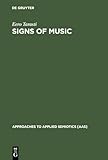Signs of Music : A Guide to Musical Semiotics / Eero Tarasti.
Material type: TextSeries: Approaches to Applied Semiotics [AAS] ; 3Publisher: Berlin ; Boston : De Gruyter Mouton, [2012]Copyright date: ©2002Edition: Reprint 2012Description: 1 online resource (224 p.)Content type:
TextSeries: Approaches to Applied Semiotics [AAS] ; 3Publisher: Berlin ; Boston : De Gruyter Mouton, [2012]Copyright date: ©2002Edition: Reprint 2012Description: 1 online resource (224 p.)Content type: - 9783110172263
- 9783110899870
- 780/.1/4
- ML3845 ǂb T348 2002eb
- online - DeGruyter
- Issued also in print.
| Item type | Current library | Call number | URL | Status | Notes | Barcode | |
|---|---|---|---|---|---|---|---|
 eBook
eBook
|
Biblioteca "Angelicum" Pont. Univ. S.Tommaso d'Aquino Nuvola online | online - DeGruyter (Browse shelf(Opens below)) | Online access | Not for loan (Accesso limitato) | Accesso per gli utenti autorizzati / Access for authorized users | (dgr)9783110899870 |
Frontmatter -- Foreword -- Contents -- Part one: Music as sign -- Chapter 1. Is music sign? -- Chapter 2. Signs in music history, history of music semiotics -- Chapter 3. Signs as acts and events: On musical situations -- Part two: Gender, biology, and transcendence -- Chapter 4. Metaphors of nature and organicism in music: A “biosemiotic” approach -- Chapter 5. The emancipation of the sign: On corporeal and gestural meanings in music -- Chapter 6. Body and transcendence in Chopin -- Part three: Social and musical practices -- Chapter 7. Voice and identity -- Chapter 8. On the semiosis of musical improvisation: From Mastersingers to Bororo indians -- Notes -- References -- Name index
restricted access online access with authorization star
http://purl.org/coar/access_right/c_16ec
Music is said to be the most autonomous and least representative of all the arts. However, it reflects in many ways the realities around it and influences its social and cultural environments. Music is as much biology, gender, gesture - something intertextual, even transcendental. Musical signs can be studied throughout their history as well as musical semiotics with its own background. Composers from Chopin to Sibelius and authors from Nietzsche to Greimas and Barthes illustrate the avenues of this new discipline within semiotics and musicology.
Issued also in print.
Mode of access: Internet via World Wide Web.
In English.
Description based on online resource; title from PDF title page (publisher's Web site, viewed 28. Feb 2023)


